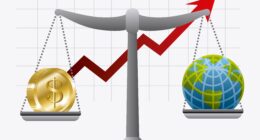Deficit is an annual shortfall in spending vs. revenue, while debt is the total amount owed accumulated over time due to deficits and borrowing.
Are you confused about the difference between deficit and debt? You’re not alone! Many people use these terms interchangeably, but they actually have distinct meanings in the world of finance. Understanding these concepts is essential for building your financial literacy and making informed decisions. Let’s dive into the definitions, implications, and importance of deficit and debt.
Key Takeaways:
- Debt refers to the amount of money owed, while a deficit occurs when spending exceeds revenue.
- Deficits can be caused by factors such as government spending exceeding tax revenue or a country’s imports exceeding its exports.
- Debt is not necessarily an indicator of a weak economy, but managing deficit and debt is crucial for financial stability.
- Reducing deficit and debt can be achieved through measures such as increasing revenue, reducing spending, and stimulating economic growth.
- Understanding the difference between deficit and debt is essential for financial literacy and creating a strong economic future.
What Is Debt?

Debt is the financial obligation that arises when an individual, company, or government borrows money from lenders or investors. It represents the amount of money owed to someone else. Debt can be incurred for various reasons, such as financing education, purchasing a home, or funding business operations.
There are different types of debt:
- Individual debt: This includes loans, credit card debt, mortgages, and personal lines of credit. Individuals borrow from banks, financial institutions, and other individuals to meet their financial needs.
- Institutional debt: Companies and organizations incur debt by issuing bonds and obtaining loans to finance their operations, expand their business, or invest in new projects.
- Government debt: Governments borrow money by issuing government bonds and securities to meet their financial obligations and fund public projects.
The U.S. government’s national debt is a significant example of government debt. In January 2024, the U.S. national debt surpassed $33.91 trillion. It encompasses various types of government securities with different maturities.
What Is a Deficit?

A deficit occurs when spending exceeds revenue, resulting in a negative balance. It is the opposite of a surplus, which occurs when revenue exceeds spending. Deficits can occur in various contexts, such as government finances, trade, and revenue projections.
Types of Deficits
There are different types of deficits that can impact an economy:
- Budget Deficits: These deficits occur when government expenses surpass tax revenue. Governments may need to borrow or increase taxes to cover the shortfall.
- Trade Deficits: A trade deficit arises when the value of a country’s imports exceeds the value of its exports. This deficit can affect currency exchange rates, employment, and economic competitiveness.
- Revenue Deficits: Revenue deficits happen when the actual net income falls short of the projected net income. This can occur in both government and corporate settings, leading to financial challenges.
The U.S., for example, is projected to face a budget deficit of $1.85 trillion in 2024, highlighting the significance of managing deficits to maintain financial stability.
[Caption: A graph illustrating the projected budget deficit of $1.85 trillion in the U.S. for 2024]Understanding the various types of deficits is essential for comprehending the complexities of financial systems and their impact on economies.
Key Differences between Debt and Deficit
Understanding the differences between debt and deficit is crucial for establishing a solid foundation in financial literacy. While these terms are often used interchangeably, they have distinct meanings and implications. Let’s explore the key differences between debt and deficit.
Repayment
One of the key distinctions between debt and deficit is the concept of repayment. Debt involves the obligation to repay both the principal amount borrowed and any accumulated interest over a specified period of time. Individuals and organizations that incur debt are bound by contractual agreements with lenders, requiring them to make regular payments until the debt is fully repaid.
On the other hand, deficits do not involve the repayment of principal or interest. Deficits simply reflect a situation where expenses exceed income or revenue during a specific time period. It represents the shortfall between what is spent and what is earned.
Sources
Debt and deficits also differ in their sources. Debt is primarily incurred through borrowing from external parties, such as banks, financial institutions, or individuals. It involves the transfer of funds from the lender to the borrower, creating a creditor-debtor relationship. The borrowed funds are typically used to finance investments, purchases, or cover operational expenses.
In contrast, deficits reflect a mismatch between revenue and spending. They can arise in various contexts, including government budgets, trade balances, or company finances. Deficits can occur due to factors such as increased spending, decreased revenue, economic downturns, or unforeseen circumstances. Unlike debt, deficits do not involve the direct transfer of funds from external sources.
Consistency
When it comes to consistency, debt and deficits also differ. Debt can change over time as borrowers make regular payments towards reducing their outstanding balances. It can increase if additional borrowing occurs or decrease as debt is gradually repaid. The level of debt can be influenced by factors such as interest rates, repayment terms, and borrowing decisions.
On the other hand, deficits can remain the same if spending and revenue are balanced. For example, if a government’s expenses and tax revenue are equal, there would be no deficit or surplus. Deficits can persist over time if spending continues to exceed revenue, and they can accumulate, leading to an increase in overall debt levels.
Overall, understanding the differences between debt and deficit is essential for making informed financial decisions. Debt entails the need for repayment of borrowed funds, while deficits represent a shortfall between expenses and revenue. By comprehending these distinctions, individuals, organizations, and governments can navigate their financial situations more effectively and work towards achieving financial stability.
Comparison of Debt and Deficit
| Aspect | Debt | Deficit |
|---|---|---|
| Definition | The amount of money owed, including principal and interest | A situation where expenses exceed income or revenue |
| Repayment | Required to pay back principal and interest | No requirement for repayment |
| Sources | Incurred through borrowing from external parties | Reflects the mismatch of revenue and spending |
| Consistency | Can change over time based on borrowing and repayment | Can remain the same if spending and revenue are balanced |
National Debt and the Budget Deficit
The U.S. national debt stands at a staggering $34.15 trillion as of February 2024(see table below for details). This represents the total amount of money that the U.S. government owes to its creditors. On the other hand, the budget deficit is the annual difference between government spending and revenue, which has been persistently running since 1970, with the exception of only four years.
It is important to note that the repayment of the national debt is primarily funded by taxpayers, who contribute through various means, such as taxes and other government revenue streams. Additionally, it is worth mentioning that China holds a significant portion of the U.S. debt, with $782 billion of U.S. sovereign debt being owned by the country(see image below). Despite this, the U.S. maintains the highest national debt globally, with China and Japan following closely behind.
| Country | National Debt ($ Trillions) |
|---|---|
| United States | 34.15 |
| China | 3.28 |
| Japan | 1.34 |
These figures highlight the substantial burden of the U.S. national debt and emphasize the need for effective fiscal policies to manage and reduce it. Ensuring transparency and accountability in the management of both the budget deficit and the national debt is vital in maintaining financial stability and safeguarding the future economic well-being of the nation.
The Federal Budget Deficit
The federal budget deficit refers to the annual difference between government spending and government revenue. It is a key measure of fiscal health and sustainability. In the case of the United States, the federal government has consistently operated with a deficit since 1970, with only four exceptions. This means that government spending has consistently exceeded government revenue over the years, leading to a buildup of debt.
Unlike in the past, deficits are no longer caused by temporary spikes in wartime or recession-related spending. Instead, they are a result of a long-term structural mismatch between spending and revenue. This ongoing deficit trend has become the norm for the U.S. government.
The impact of deficits on the economy can be profound. In order to cover obligations when spending exceeds revenue, the government may resort to increased borrowing. This can have long-term consequences, such as higher interest payments and a heavier debt burden, potentially leading to economic instability.
The Federal Debt
The federal debt is a significant financial obligation that the U.S. government owes. It represents the cumulative amount of money borrowed over time to cover past deficits, with deficits occurring when government spending exceeds revenue. The federal debt is a result of the government’s borrowing activities and is a crucial component of the national economy.
To finance deficits, the government resorts to borrowing from various sources. One common method is by selling Treasury bonds, bills, and other securities to investors. These securities represent a promise to repay the principal amount borrowed, as well as the interest owed to the investors who purchased them. This interest, considered the cost of borrowing, can accumulate to substantial sums and impact the budget.
The federal debt has been steadily growing due to recurring deficits, creating implications for the national budget. As the debt continues to accumulate, the government must allocate a portion of its budget for interest payments on the outstanding debt. This diverts funds away from other essential programs and initiatives, potentially limiting the government’s ability to address pressing national needs.
Understanding the federal debt is crucial because it affects the overall financial health of the nation. As the debt increases, it poses challenges for policymakers in balancing the budget and managing the economy effectively. It requires careful consideration and strategic planning to minimize borrowing, reduce deficits, and maintain fiscal stability.
| Key Points about the Federal Debt |
|---|
| The federal debt represents the accumulated amount of money the government owes. |
| Borrowing through the sale of Treasury securities is a common method to finance deficits. |
| The debt includes the principal amount borrowed and the interest owed to investors. |
| Recurring deficits contribute to the growth of the federal debt over time. |
| The federal debt impacts the national budget through interest payments. |
Managing the federal debt is crucial for ensuring the long-term financial stability and well-being of the nation. It requires implementing strategies to reduce deficits, control spending, increase revenue, and stimulate economic growth. By addressing the challenges posed by the federal debt, policymakers can work towards a more secure financial future for the country.
The Relationship between Deficit and Debt
Running a deficit can contribute to the increase in the level of debt an entity has. Deficit spending occurs when spending continues to outpace revenue, leading to an accumulation of debt. Both individuals and governments can run deficits, and deficits can be unsustainable over time. Deficits come with a negative connotation, but they can also be utilized to boost economic growth by increasing spending.
Deficits play a significant role in the relationship between deficit and debt. When an entity spends more money than it earns, it incurs a deficit. This deficit can be covered by borrowing, which leads to an increase in debt. The deficit contributes to the accumulation of debt, and if deficits persist over an extended period, it can lead to a substantial burden of debt.
Deficits can be seen as a necessary evil in certain situations. In times of economic downturn or crisis, governments may engage in deficit spending to stimulate the economy. By injecting funds into various sectors, such as infrastructure development or job creation, deficit spending aims to boost economic activity and drive growth. However, it is crucial to strike a balance and ensure that deficits are sustainable and manageable in the long run.
Deficit Spending and Economic Growth
Deficit spending can be an effective tool for promoting economic growth. By increasing government expenditure, deficits can fuel demand and stimulate economic activity. For example, when the government invests in public infrastructure projects, it creates jobs and generates income for workers, which leads to increased consumer spending. This, in turn, can stimulate economic growth and productivity.
However, it is essential to carefully manage deficit spending to avoid excessive debt accumulation and potential negative consequences. Uncontrolled deficit spending can lead to inflation, diminished investor confidence, and higher interest rates, making it more difficult for governments and individuals to service their debts. Therefore, prudent fiscal policies and responsible management of deficits are crucial to maintain the delicate balance between stimulating economic growth and ensuring long-term financial stability.
Managing Deficit and Debt
Managing deficit and debt is crucial for maintaining fiscal stability and securing a strong economic future. Failure to control deficit and debt can have significant implications, leading to economic instability, recessions, and devaluation of currency.
To address these challenges, governments must implement effective measures to reduce deficit and debt. This includes increasing revenue through strategic taxation policies, carefully managing government spending, and finding ways to stimulate economic growth.
Implementing fiscal responsibility and effectively managing deficit and debt play a vital role in ensuring long-term financial sustainability and economic prosperity. By reducing deficit and debt, countries can create a favorable economic environment, encouraging investment, promoting job creation, and fostering economic growth.
The Importance of Managing Deficit and Debt
Proper management of deficit and debt is essential for several reasons:
- 1. Economic Stability: Managing deficit and debt helps maintain stability in the economy, safeguarding against potential crises caused by excessive borrowing and spending.
- 2. Investor Confidence: Effective deficit and debt management instills confidence in investors, ensuring they continue to invest in the country’s financial markets.
- 3. Lower Interest Rates: Reducing deficit and debt can lead to lower interest rates, which benefits the government, businesses, and individuals by reducing borrowing costs.
- 4. Reduced Inflationary Pressure: Managing deficit and debt helps control inflationary pressures, preventing excessive price increases that can negatively impact the economy.
To illustrate the importance of managing deficit and debt, consider the example of countries with uncontrolled deficit and debt. These nations often face severe economic and financial challenges, including high unemployment rates, limited access to credit, and decreased investor confidence.
Reducing Deficit and Debt: A Strategic Approach
Reducing deficit and debt requires a strategic and comprehensive approach:
- 1. Increase Revenue: Governments can increase revenue by implementing fair and effective taxation policies, closing loopholes, and combating tax evasion.
- 2. Control Spending: Governments should closely monitor and manage public spending, focusing on essential areas while eliminating unnecessary expenditures.
- 3. Promote Economic Growth: Stimulating economic growth through measures such as infrastructure investments, innovation, and supporting small businesses can increase revenue and reduce the need for borrowing.
- 4. Prioritize Debt Repayment: Allocating resources to prioritize debt repayment is essential to gradually reduce the overall debt burden.
By adopting a strategic approach that includes these measures, governments can gradually reduce deficit and debt, ensuring long-term financial stability and economic prosperity.
Conclusion
Understanding the difference between deficit and debt is essential for financial literacy. Debt refers to the amount of money owed, while a deficit occurs when spending exceeds revenue. These two terms have distinct implications for individuals, companies, and governments, and managing them is crucial for financial stability and long-term economic growth.
By addressing deficits and controlling debt, policymakers can create positive conditions for economic prosperity and ensure a brighter future for the next generation. It is important to recognize that debt is not necessarily an indicator of a weak economy, and deficits can be utilized to stimulate economic growth. However, it is equally important to strike a balance and avoid excessive accumulation of debt, as uncontrolled deficit and debt can lead to economic instability, recessions, and devaluation of currency.
Therefore, it is crucial for governments to implement measures that reduce deficits and control debt, such as increasing revenue through taxes, reducing unnecessary spending, and finding ways to stimulate economic growth. Taking fiscal responsibility and managing deficit and debt contribute to a strong economic future and pave the way for long-term prosperity.
FAQ
What is the difference between deficit and debt?
Debt refers to the amount of money owed to someone else, while a deficit occurs when spending exceeds revenue over a specific period of time.
What is the definition of deficit and debt?
Debt is the total amount of money owed, while a deficit is the situation where costs exceed income.
What are some key differences between debt and deficit?
Debt involves the need to repay principal and interest, while deficits do not involve these payments. Debt is incurred through borrowing, while deficits simply reflect the mismatch of revenue and spending.
How does deficit contribute to debt?
Running a deficit occurs when spending continues to outpace revenue, leading to an accumulation of debt.
Why is managing deficit and debt important?
Uncontrolled deficit and debt can lead to economic instability, recessions, and devaluation of currency. Managing deficit and debt is crucial for fiscal stability and long-term economic growth.
Source Links
- https://www.pgpf.org/blog/2023/02/debt-vs-deficits-whats-the-difference
- https://www.investopedia.com/articles/personal-finance/081315/debt-vs-deficit-understanding-differences.asp
- https://fiscaldata.treasury.gov/americas-finance-guide/national-deficit/
Image Credits
Featured Image By – jcomp on Freepik
Image 1 By – drobotdean on Freepik
Image 2 By – 8photo on Freepik








